spare wheel OLDSMOBILE SILHOUETTE 1997 Owners Manual
[x] Cancel search | Manufacturer: OLDSMOBILE, Model Year: 1997, Model line: SILHOUETTE, Model: OLDSMOBILE SILHOUETTE 1997Pages: 436, PDF Size: 21.87 MB
Page 290 of 436
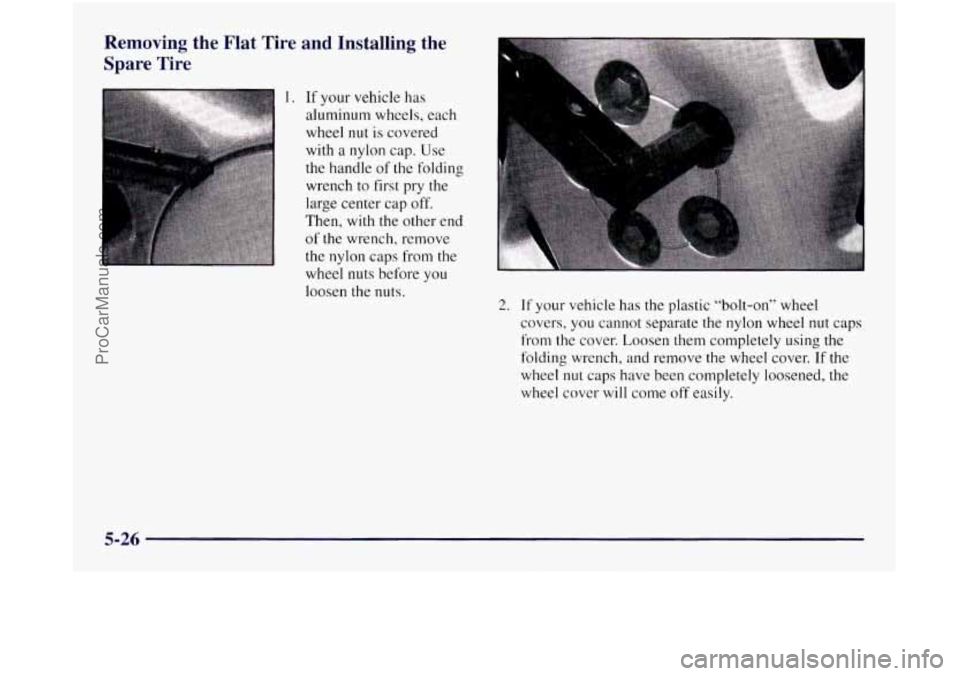
Removing the Flat Tire and Installing the
Spare Tire
1. If your vehicle has
aluminum wheels, each
wheel
nut is covered
with
a nylon cap. Use
the handle of the folding
wrench
to first pry the
large center cap
off.
Then, with the other end
of the wrench, remove
the nylon caps from the
wheel nuts before
you
loosen the nuts.
2. If your vehicle has the plastic “bolt-on” wheel
covers, you cannot separate the nylon wheel
nut caps
from the cover. Loosen then1 completely using
the
folding wrench, and remove the wheel cover. If the
wheel
nut caps have been completely loosened, the
wheel cover will come off easily.
5-26
ProCarManuals.com
Page 292 of 436
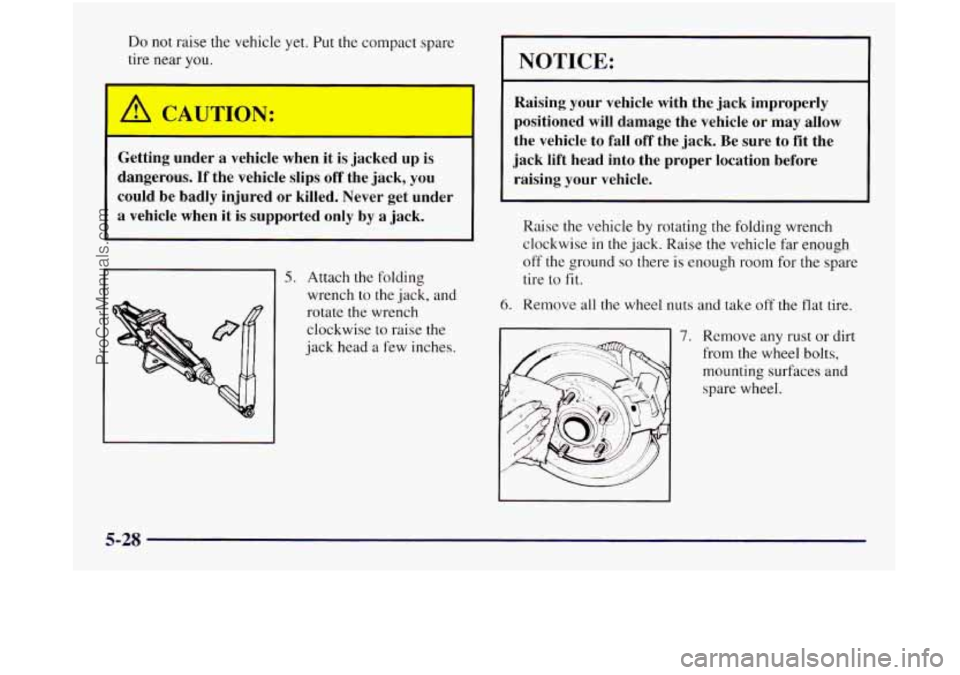
Do not raise the vehicle yet. Put the conlpact spare
tire near
you.
Getting under a vehicle when it is jacked up is
dangerous.
If the vehicle slips off the jack, you
could be badly injured or killed. Never get under
a vehicle when it
is supported only by a jack.
-1 5. Attach the folding
wrench to the jack, and
rotate
the wrench
clockwise to raise the
jack head
a few inches.
NOTICE:
Raising your vehicle with the jack improperly
positioned will damage the vehicle or may allow
the vehicle to fall off the jack. Be sure to fit the
jack lift head into the proper location before
raising your vehicle.
Raise the vehicle by rotating the folding wrench
clockwise
in the jack. Raise the vehicle far enough
off the ground
so there is enough room for the spare
tire to
fit.
6. Remove all the wheel nuts and take off the flat tire.
7. Remove any rust or dirt
from the wheel bolts,
mounting surfaces and
spare wheel.
5-28
ProCarManuals.com
Page 293 of 436
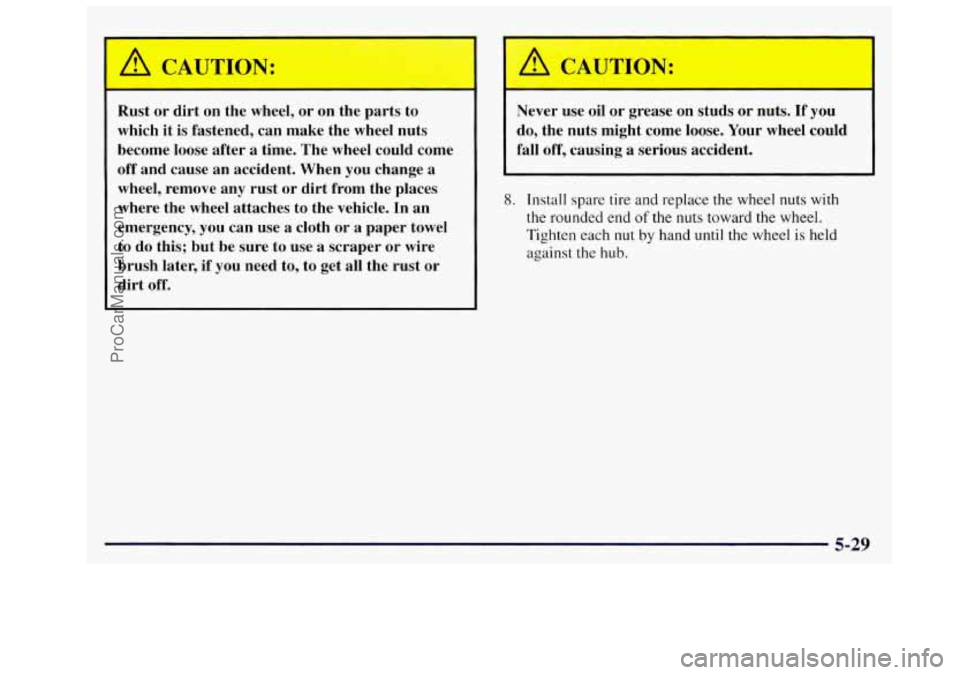
Rust or dirt on the wheel, or on the parts to
which it is fastened, can make the wheel nuts
become loose after a time. The wheel could come
off and cause an accident. When you change a
wheel, remove any rust or dirt from the places
where the wheel attaches to the vehicle. In an
emergency, you can use a cloth or
a paper towel
to do this; but be sure to use
a scraper or wire
brush later, if you need
to, to get all the rust or
dirt off.
A CAUTION: I
Never use oil or grease on studs or nuts. If you
do, the nuts might come loose. Your wheel could
fall off, causing
a serious accident.
8. Install spare tire and replace the wheel nuts with
the rounded end
of the nuts toward the wheel.
Tighten each
nut by hand until the wheel is held
against the hub.
5-29
ProCarManuals.com
Page 295 of 436
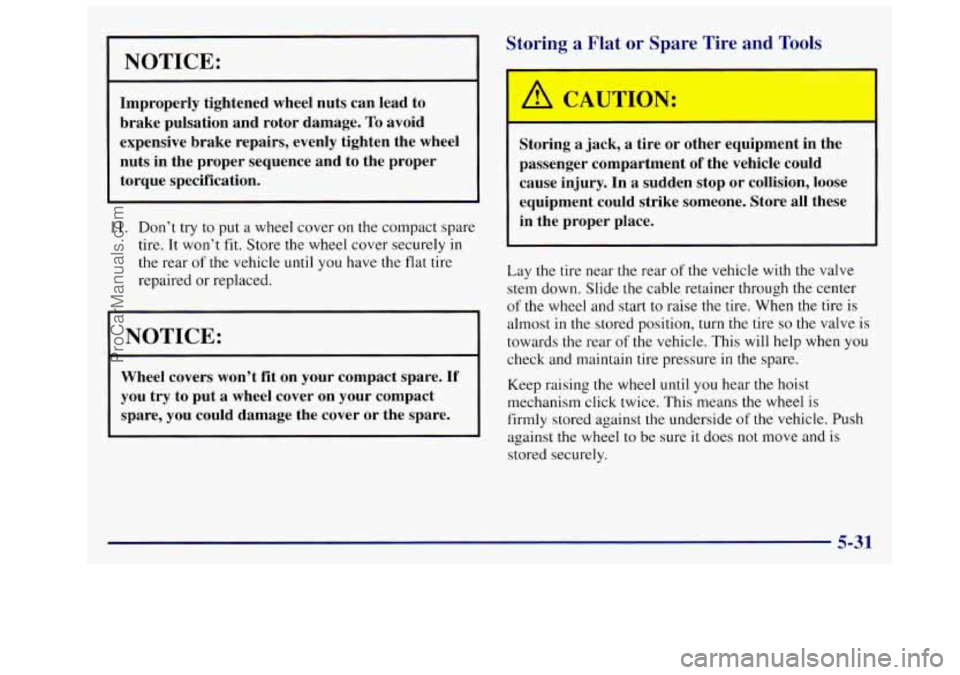
NOTICE:
Improperly tightened wheel nuts can lead to brake pulsation and rotor damage.
To avoid
expensive brake repairs, evenly tighten the wheel
nuts in the proper sequence and to the proper
torque specification.
11. Don’t try to put
a wheel cover on the compact spare
tire. It won’t fit. Store
the wheel cover securely in
the rear of the vehicle until you have the flat tire
repaired or replaced.
1 NOTICE:
Wheel covers won’t fit on your compact spare. If
you try to put a wheel cover on your compact
spare, you could damage the cover or the spare.
Storing a Flat or Spare Tire and Tools
Storing a jack, a tire or other equlpment in the
passenger compartment
of the vehicle could
cause injury. In
a sudden stop or collision, loose
equipment could strike someone. Store
all these
in the proper place.
Lay the tire near the rear of the vehicle with the valve
stem down. Slide the cable retainer through the center
of the wheel and start to raise the tire. When the tire is
almost in
the stored position, turn the tire so the valve is
towards the rear of the vehicle. This will help when you
check and maintain tire pressure
in the spare.
Keep raising the wheel
until you hear the hoist
mechanism click twice. This means the wheel is
firmly stored against the underside of the vehicle. Push
against the wheel to be sure it does
not move and is
stored securely.
ProCarManuals.com
Page 296 of 436
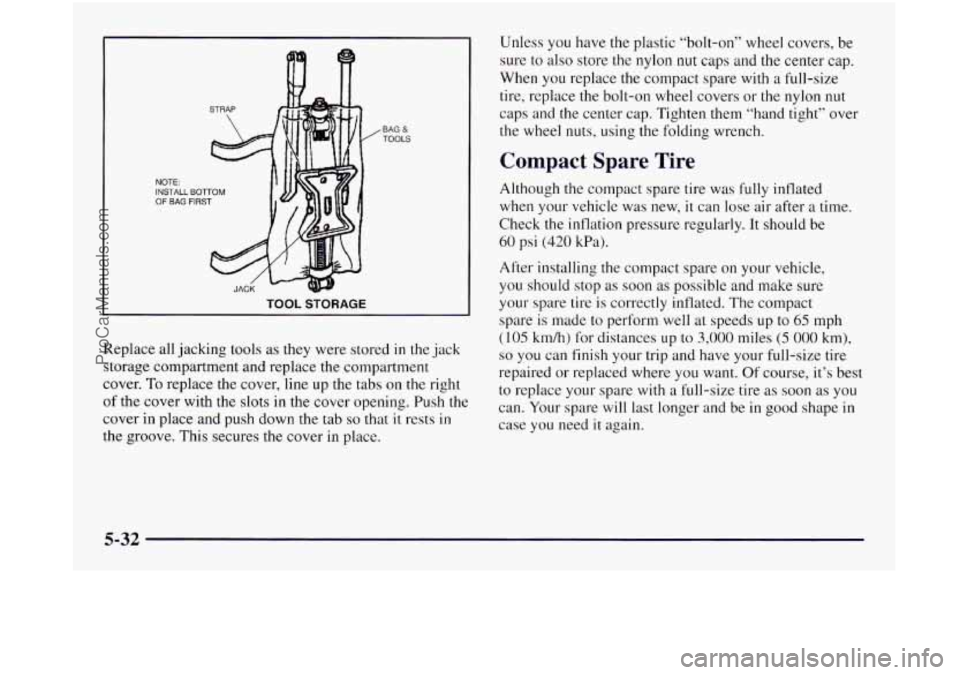
NOTE: INSTALL OF BAG - BOTTOM FIRST
TOOL STORAGE
BAG & TOOLS
Replace all jacking tools as they were stored in the jack
storage compartment and replace the compartment
cover.
To replace the cover, line up the tabs on the right
of the cover with
the slots in the cover opening. Push the
cover in place and push down the tab
so that it rests in
the groove. This secures the cover in place. Unless
you have
the plastic “bolt-on” wheel covers, be
sure to also store the nylon
nut caps and the center cap.
When
you replace the compact spare with a full-size
tire, replace the bolt-on wheel covers or
the nylon nut
caps and
the center cap. Tighten them “hand tight” over
the
wheel nuts, using the folding wrench.
Compact Spare Tire
Although the compact spare tire was fully inflated
when your vehicle was new, it can lose air after a time.
Check the inflation pressure regularly. It should be
60 psi (420
kPa).
After installing the compact spare on your vehicle,
you should stop
as soon as possible and make sure
your spare
tire is correctly inflated. The compact
spare is made to perform well at speeds up to
65 mph
(105 km/h) for distances
up to 3,000 miles (5 000 km),
so you can finish your trip and have your full-size tire
repaired or replaced where you want. Of course, it’s best
to replace your spare
with a full-size tire as soon as you
can. Your spare will last longer and be
in good shape in
case you need it again.
5-32
ProCarManuals.com
Page 297 of 436
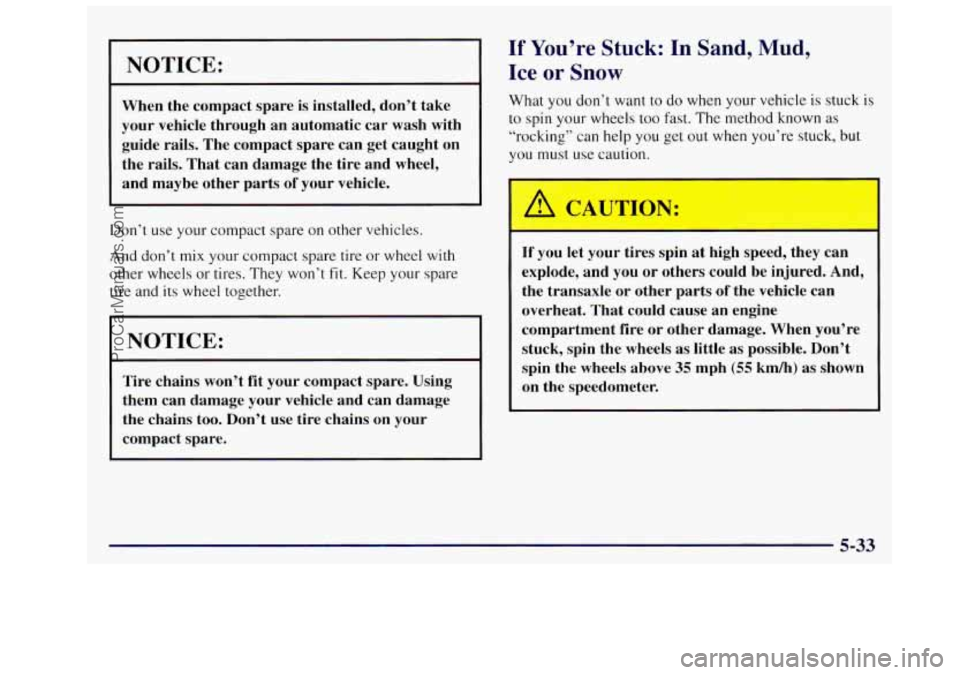
NOTICE:
When the compact spare is installed, don’t take
your vehicle through an automatic car wash with
guide rails. The compact spare can get caught on
the rails. That can damage the tire and wheel,
and maybe other parts
of your vehicle.
Don’t use your compact spare on other vehicles.
And don’t mix your compact spare
tire or wheel with
other wheels or tires. They won’t
fit. Keep your spare
tire and its wheel together.
NOTICE:
Tire chains won’t fit your compact spare. Using
them can damage your vehicle and can damage
the chains too. Don’t use tire chains
on your
compact spare.
If You’re Stuck: In Sand, Mud,
Ice
or Snow
What you don’t want to do when your vehicle is stuck is
to spin your wheels too fast. The method known as
“rocking’’ can help you get out when you’re stuck, but
you must use caution.
If you let your tires spin at high speed, they can
explode, and you or others could be injured. And,
the transaxle or other parts
of the vehicle can
overheat. That could cause an engine compartment fire or other damage. When you’re
stuck, spin the wheels as little as possible. Don’t
spin the wheels above
35 mph (55 km/h) as shown
on the speedometer.
5-33
ProCarManuals.com
Page 339 of 436
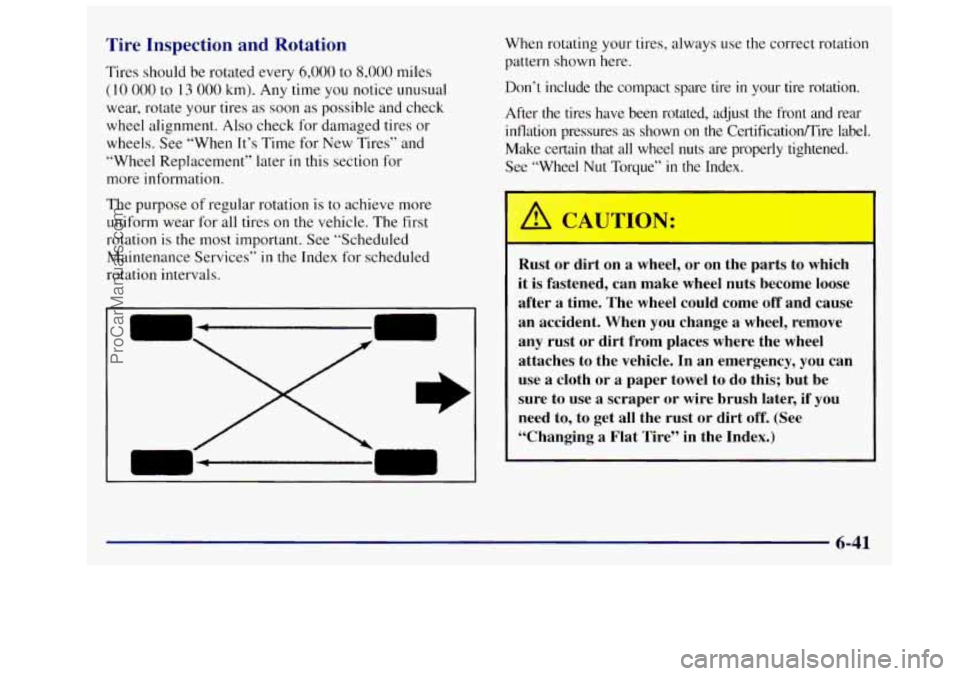
Tire Inspection and Rotation
Tires should be rotated every 6,000 to 8,000 miles
(10 000 to 13 000 km). Any time you notice unusual
wear, rotate your tires
as soon as possible and check
wheel alignment. Also check for damaged tires or
wheels. See “When It’s Time for New Tires” and
“Wheel Replacement” later
in this section for
more information.
The purpose of regular rotation is
to achieve more
uniform wear for all tires on the vehicle. The first
rotation is the most important. See “Scheduled
Maintenance Services”
in the Index for scheduled
rotation intervals. When
rotating
your tires, always use the correct rotation
pattern shown here.
Don’t include the compact spare tire
in your tire rotation.
After the tires have been rotated, adjust the front and rear
inflation pressures
as shown on the Certificatioflire label.
Make certain that all wheel
nuts are properly tightened.
See “Wheel Nut Torque”
in the Index.
Rust or dirt on
a wheel, or on the parts to which
it is fastened, can make wheel nuts become loose
after
a time. The wheel could come off and cause
an accident. When you change a wheel, remove
any rust or dirt from places where the wheel
attaches to the vehicle. In an emergency, you can
use
a cloth or a paper towel to do this; but be
sure to use
a scraper or wire brush later, if you
need to, to get
all the rust or dirt off. (See
“Changing a Flat Tire” in the Index.)
6-41
ProCarManuals.com
Page 341 of 436
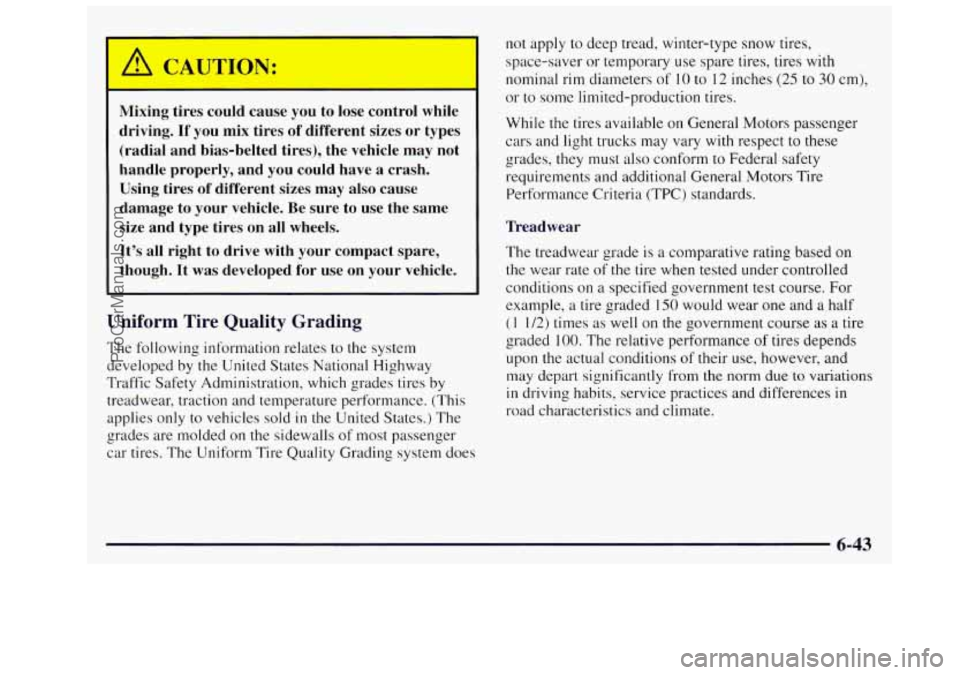
Mixing tires could cause you to lose control while
driving.
If you mix tires of different sizes or types
(radial and bias-belted tires), the vehicle may not
handle properly, and you could have a crash.
Using tires of different sizes may also cause
damage to your vehicle. Be sure to use the same
size and type tires on all wheels.
It’s
all right to drive with your compact spare,
though. It was developed
for use on your vehicle.
Uniform Tire Quality Grading
The following information relates to the system
developed by the United States National Highway
Traffic Safety Administration, which grades tires by
treadwear, traction and temperature performance. (This
applies only to vehicles sold
in the United States.) The
grades are molded on the sidewalls of most passenger
car tires. The Uniform Tire Quality Grading system does not
apply to deep tread, winter-type snow tires,
space-saver or temporary use spare tires, tires with
nominal rim diameters
oC 10 to 12 inches (25 to 30 cm),
or to some limited-production tires.
While the tires available on General Motors passenger
cars and light trucks may vary with respect to these
grades,
they must also conform to Federal safety
requirements and additional General Motors Tire Performance Criteria (TPC) standards.
Treadwear
The treadwear grade is a comparative rating based
on
the wear rate of the tire when tested under controlled
conditions on
a specified government test course. For
example,
a tire graded 150 would wear one and a half
( 1 1/2) times as well on the government course as a tire
graded
100. The relative performance of tires depends
upon the actual conditions of their use, however, and
may depart significantly from the norm due to variations
in driving habits, service practices and differences in
road characteristics and climate.
6-43
ProCarManuals.com
Page 423 of 436

Fabric ...................................... 6-47
Class
....................................... 6-50
Inside
of Your Oldsmobile ...................... 6-47
Instrument Panel
............................. 6-49
Outside of Your Oldsmobile
.................... 6-50
Special Problems
............................. 6-48
Stains
...................................... 6-48
Tires
....................................... 6-52
Vinyl ....................................... 6-48
Wheels
..................................... 6-52
Windshield and Wiper Blades
................... 6-50
Climate Control System
........................... 3-2
Clock. Setting the
................................ 3-9
Coinholder
.................................... 2-74
Comfort Controls
................................ 3- 1
Compact Disc Care ............................. 3-30
Compact Disc Player
............................ 3- 19
Compact Disc Player Errors
....................... 3-21
Compact Disc Player. Remote
..................... 3-17
Compact Overhead Console
...................... 2-68
Compact Spare Tire
............................. 5-32
Content Theft Deterrent
.......................... 2-23
Control of
a Vehicle .............................. 4-6
Convenience Net
............................... 2-76
Side
....................................... 2-78
Convex Outside Mirror
.......................... 2-67
Coolant
....................................... 6-20
Adding
..................................... 6-23
Checking
................................... 6-22 Heater.
Engine
............................... 2-29
RecoveryTank
............................... 5-16
Whattouse ................................. 6-21
Courtesy Transportation
........................... 8-6
Cruise Control
................................. 2-55
Cupholders
.................................... 2-74
Customer Assistance for Text Telephone Users
......... 8-4
Customer Assistance Information
................... 8-1
Customer Satisfaction Procedure .................... 8-2
Damage. Finish
............................... 6-52
Damage. Sheet Metal
............................ 6-52
Daytime Running Lamps
......................... 2-59
Dead Battery
................................... 5-3
Defects? Reporting Safety ......................... 8-8
Defensive Driving
............................... 4-2
Defogger. Rear Window
.......................... 3-8
Defrosting
..................................... 3-8
Delayed Illumination
............................ 2-63
Dimensions. Vehicle ............................ 6-63
Door Locks
....................................... 2-3
Power Sliding
................................ 2-15
Sliding
..................................... 2-13
Door Ajar Light
............................... 2- 104
Driver Information Center
........................ 2-71
DriverPosition
................................. 1-34
Defogging
..................................... 3-8
ProCarManuals.com
Page 431 of 436
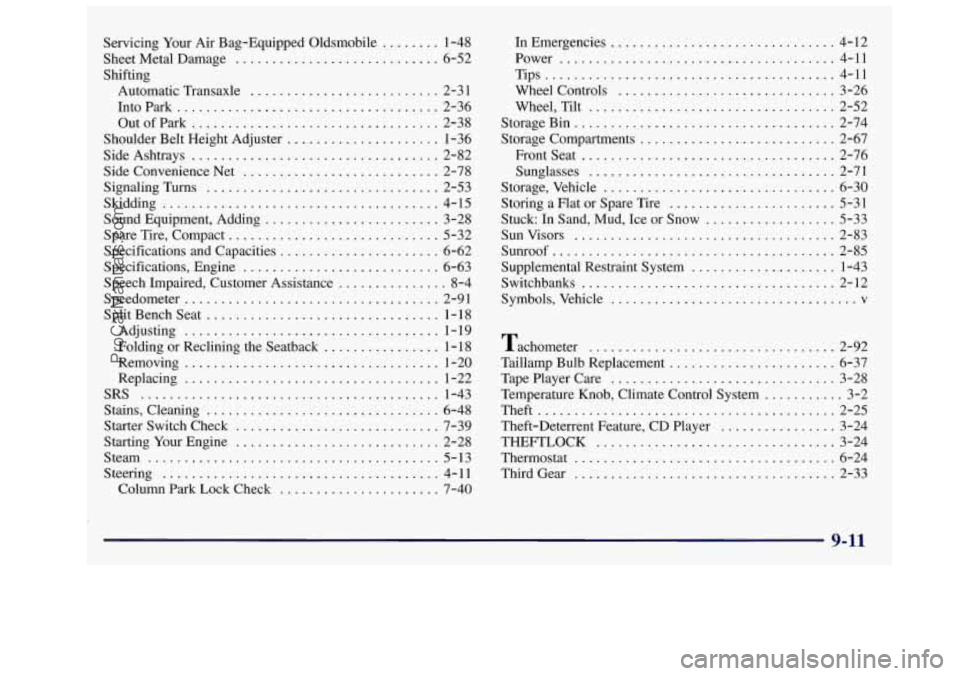
Servicing Your Air Bag-Equipped Oldsmobile ........ 1-48
Sheet Metal Damage
............................ 6-52
Automatic Transaxle
.......................... 2-3 1
Intopark
.................................... 2-36
Outofpark
.................................. 2-38
Shifting
. Shoulder Belt Height
Adjuster ..................... 1-36
SideAshtrays
.................................. 2-82
Side Convenience Net
........................... 2-78
Signaling Turns
................................ 2-53
Skidding
...................................... 4-15
Sound Equipment. Adding
........................ 3-28
Specifications and Capacities
...................... 6-62
Specifications. Engine
........................... 6-63
Speech Impaired. Customer Assistance
............... 8-4
Speedometer
................................... 2-91
SplitBenchSeat
................................ 1-18
Adjusting
................................... 1-19
Folding or Reclining the Seatback
................ 1 - 18
Removing
................................... 1-20
Replacing
................................... 1-22
Stains. Cleaning
................................ 6-48
Starter Switch Check
............................ 7-39
Starting Your Engine
............................ 2-28
Stem
........................................ 5-13
Steering
...................................... 4-11
Column Park Lock Check
...................... 7-40
Spare
Tire. Compact
............................. 5-32
SRS
......................................... 1-43 In Emergencies
............................... 4-
12
Power
...................................... 4-11
Tips
........................................ 4-11
Wheel Controls
.............................. 3-26
Wheel. Tilt
.................................. 2-52
StorageBin
.................................... 2-74
Storage Compartments
........................... 2-67
Frontseat
................................... 2-76
Sunglasses
.................................. 2-71
Storage. Vehicle
................................ 6-30
Stuck: In Sand. Mud. Ice or Snow
.................. 5-33
Sunvisors
.................................... 2-83
Sunroof
....................................... 2-85
Supplemental Restraint System
.................... 1-43
Switchbanks
................................... 2-12
Symbols. Vehicle
.................................. v
Storing a Flat or Spare Tire ....................... 5-31
Tachometer .................................. 2-92
Taillamp Bulb Replacement
....................... 6-37
TapePlayerCare
............................... 3-28
Temperature Knob. Climate Control System
........... 3-2
Theft
......................................... 2-25
Theft-Deterrent Feature. CD Player
................ 3-24
THEFTLOCK
................................. 3-24
Thermostat
.................................... 6-24
Third Gear
.................................... 2-33
9-11
ProCarManuals.com